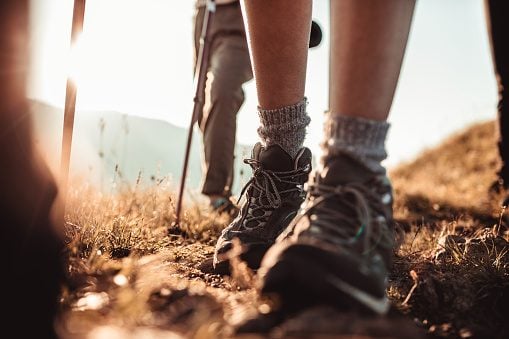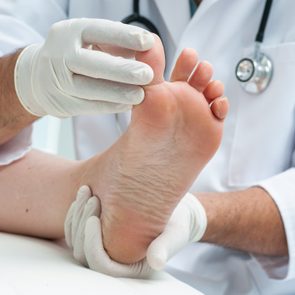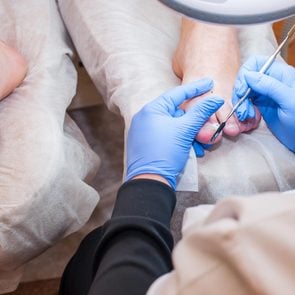6 Things That Can Cause a Black Toenail and Treatments That Help
Updated: May 18, 2021
From trauma to a toenail fungus, there are many reasons why you may have a black toenail or black spots on a toenail. Here's what it means, how to treat them—and when you should call your doctor.
Why is my toenail black?
You might have dealt with a fungus that causes yellow toenails or white toenails, but discovering a black toenail can be a bit alarming.
Unless you remember that you stubbed your toe recently, you’re probably wondering how you got it and what it means.
There are a few reasons why your toenail is turning black or has black spots on it. Most don’t impact your overall health much, but some types of black toenails should definitely be checked out by your doctor as soon as possible.
Here are some reasons for a black toenail, how to treat it, and the ways you can prevent it.
Why you might have a black spot on a toenail
Blunt force trauma
Nothing elicits profanity as much as when a heavy object lands on your toe.
It’s painful and, depending on the severity, can cause a black toenail. This occurs because blood can accumulate under the nail.
“Often this blood accumulates directly at the site of injury, which can be at the cuticle, in the middle of the nail, or closer to the tip,” says Joseph Zahn, MD, a dermatologist and assistant professor of dermatology at the George Washington University Medical Faculty Associates, Washington, D.C.
It can take several months for the black spot to move toward the tip and grow out with the nail.
In some cases, when intense toe pain and pressure from the nail bed are present, a doctor may need to drain the blood from under the nail. Never do this yourself. You could trigger an infection or cause more damage to the nail bed.
Eventually, the nail may look like it is coming loose from the nail bed. As tempting as it might be to pull it, let it fall off on its own, Dr. Zahn says.
“The nail serves as the protector of the sensitive skin underneath, and it will be more comfortable to keep it until it falls off naturally.”
Keep the toenail clean. If a piece of the toenail comes off creating a wound, apply antibiotic ointment and a bandage. Replace the bandage and reapply the antibiotic ointment daily until the wound closes up.
 Repetitive trauma
Repetitive trauma
Playing sports, running, or hiking hardly seems traumatic, but your toes beg to differ, especially if they are inside improperly fitting shoes, constantly getting pushed up against the cramped insides of the shoes.
“These individuals are also likely to have bleeding under the nail due to trauma and can result in thicker nails over time,” says dermatologist Shari Lipner, MD, an associate professor of clinical dermatology at Weill Cornell Medicine, New York.
The dried blood under the skin causes black toenails related to running, hiking, or sports.
Follow the treatment plan for blunt force trauma. Wear cushioning pads if the toe hurts. (Got pain on top of your foot? Here’s why.)
Toenail fungus (onychomycosis)
Otherwise known as toenail fungus, onychomycosis can cause brownish-black discoloration on the nails.
Distal subungual onychomycosis, a subtype, is a very common toenail fungus and the type most likely to cause brownish-black streaks in the center of the toenail.
The fungus can invade underneath any toenail, but it tends to target the big toe the most.
As the fungus grows, there may be some mild discomfort and inflammation, and the toenail typically grows thicker, gets chipped or jagged, and lifts from the nail bed.
With prescription antifungal medications applied daily for several months, the symptoms usually clear up, and the streaks grow out as the toenail grows.
A rare but serious form of skin cancer (acral melanoma)
If you spot a blackish-brown vertical streak or a triangle of brown-black pigment that goes along the entire length of the nail, call your doctor immediately.
Dr. Zahn says these are the hallmark signs of acral melanoma, a severe and aggressive form of skin cancer found on the soles of feet, palms of the hand, and under fingernails or toenails.
Although rare, acral melanoma is the most common type of melanoma among people with darker skin.
If undetected, the black pigment can grow larger and wider. As the tumor progresses, it can become itchy, painful, and spontaneously bleed. Catching and diagnosing this melanoma is tricky, but timing is critical.
“As they are caught late, they have the opportunity to spread or metastasize other places and become more difficult to treat, or require more extensive surgery to remove them from the nail,” explains Dr. Zahn.
The exact treatment varies depending on the biopsy results.
A biopsy determines how thick the melanoma is under the skin and how much needs to be removed. “For all melanomas, the melanoma and a rim of healthy tissue surrounding the melanoma are removed to ensure all of the melanoma is taken out,” says Dr. Zahn.
An infection (paronychia)
You may have never heard of it before, but paronychia is actually one of the most common hand infections in the United States (and it does happen on the toes, too). It’s an infection that occurs on the skin around the nail.
People who tend to bite their nails, pull off hangnails, get ingrown toenails, or have their hands in water daily, are more prone to paronychia.
It’s far more common on the hands than the feet.
But it can happen on toenails too, especially if the skin around the toenail gets pierced by an ingrown toenail or injury.
The nails become painfully tender, and swollen, with red skin around the toenail and yellow pus under the cuticles.
Acute paronychia
Acute paronychia comes on suddenly from a trauma that pierces the skin, like an ingrown toenail or after pulling off that irritating hanging toenail that keeps snagging on the blanket. (Always use nail scissors or nail clippers).
Staphyloccocus (staph) bacteria is the primary culprit of the infection, causing pain and tender skin. Foot soaks and oral antibiotics or topical antibiotics usually clear it up in a few days.
Chronic paronychia
Chronic paronychia is more common in people who repeatedly have their hands in water containing irritants, chemicals, or detergents that have trauma to the skin of the hands.
Still, sometimes the toes are affected for the same reason. The toenails can become brittle and rigid, and a portion of the toenail can turn a greenish-black color.
“If the patient has paronychia at the site of the ingrown nail, then dermatologists may prescribe an oral antibiotic, possibly along with mupirocin, an antibiotic ointment that works well against Staphylococcal infections,” says dermatologist Marcia Driscoll, MD, associate professor of dermatology, University of Maryland School of Medicine in Baltimore.
Over-the-counter antibiotics can cause allergic reactions, so dermatologists rarely suggest them, Dr. Driscoll says.
Frequently, oral and topical prescription antifungal medicines are also necessary. It’s essential to keep the toes as clean and dry as possible while fighting chronic paronychia.
Washboard nails
Here, nails look like dirty washboards, with grooves that are dark brown to blackish. The habitual picking or pushing back of the cuticles causes injury under the nail each time you do it.
Over time, the blood trapped under the toenail from the trauma makes blackish grooves on the toenail.
“With chronic picking, melanocytes (pigment-producing cells) in the nail matrix (nail growth center) activate to make pigment,” explains Dr. Lipner.
The pigment gets mixed in and creates washboard-like grooves. If you stop picking, the blood will grow out with the nail. If you don’t stop picking the cuticles, the discoloration can be permanent.
Breaking the habit is doable but you might need help from a mental health professional.
Washboard nails are associated with the compulsive disorder called onychotillomania.
Tips to avoid getting black toenails
You can’t prevent some of the things that cause black toenails, like accidents that cause injuries to your toes.
But you can follow these tips for healthy toenails.
Practice good nail hygiene
Routinely check your toes and feet after bathing. You’ll spot trouble and be able to treat concerns faster.
Don’t wear nail polish longer than a week or two.
You can’t spot changes in your toenail if they’re covered in polish all the time.
Trim your toenails straight across with slightly rounded corners.
Sharp corners invite toenails to grow into the sides of the skin and cause sore ingrown toenails.
Take a warm foot bath and moisturize
Soften thicker toenails that are difficult to cut.
Place your feet in a warm bath using about a teaspoon of salt per pint of water. Let them soak for about 10 minutes. Dry thoroughly.
Moisturize your toenails to make them easier to cut.
Don’t forget the skin surrounding the nails. Dry and cracking skin is vulnerable to bacteria and fungus.
Wear comfortable footwear
Wear properly fitted shoes. If you play sports, get a professional fitting.
Wear shoes and socks that breathe and wick sweat and moisture away from your feet.
Don’t walk barefoot in locker changing rooms, public showers, and pool decks. Put sunscreen on your toes when your feet are exposed to the sun.
Call your doctor
Don’t hesitate to call your doctor if you have a toenail injury, redness, pus, swelling, or anything that doesn’t feel or look right around your toe.
This is is especially important if you have diabetes or circulation problems.






















